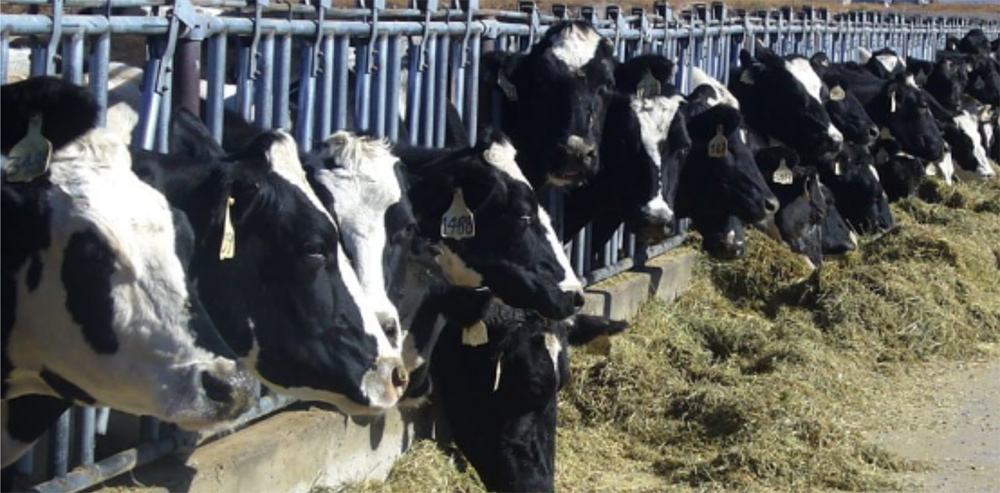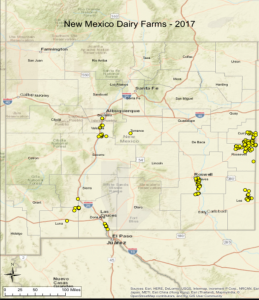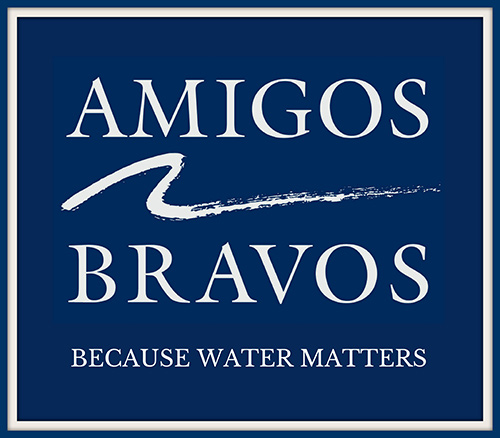Amigos Bravos is working to hold the dairy industry accountable so that
New Mexico’s drinking water will be safe for future generations.

Dairy operation in southern New Mexico. Photo: New Mexico Dept. of Agriculture
New Mexico has 131 dairies, with the largest average herd size (about 2,900 per dairy) in the nation. According to New Mexico State University (NMSU), In the last several years, New Mexico has become a national leader in cheese and milk production. It’s averaging 685,051,125 pounds of milk per month and a total of 8,220,613,505 pounds in 2018. This calculates more than 164,000 tanker loads of raw milk a year generated in the State of New Mexico alone.
Dairies Mean Manure
Dairies in New Mexico generate almost 6,400,000 gallons of manure every day. That’s as much waste as 800,000 residents in Albuquerque, Las Cruces, Rio Rancho, Roswell, and North Valley and South Valley in Bernalillo County combined send to their wastewater treatment plants daily.

Dairies in New Mexico have polluted groundwater as shallow as 3-4 ft and as deep as 400 ft. and everything in-between. According to New Mexico Environment Department (NMED) data, nearly 2/3’s of the state’s dairies currently violate state groundwater standards for nitrates; if other violations of groundwater standards are included, the number of dairies in violation increases. See below for a map of New Mexico’s dairy farms
Manure Means Contamination
Dairies are required to capture wastewater and store it in lagoons for use as nutrients for nearby crops or to evaporate. For decades, these lagoons were lined with manure itself, then with clay, both of which are known to leak dangerous levels of nitrates and pharmaceuticals into the ground and into drinking water aquifers.
New Mexico Environment Department monitoring data show that two-thirds of New Mexico’s dairies have contaminated groundwater with excess nitrogen from cattle manure. Ninety percent of New Mexico’s drinking water is drawn from groundwater sources.
The contaminants entering New Mexico’s drinking water supply pose a number of risks to water quality and public health. In addition to Nitrates, E. coli and Salmonella, other pathogens, hormones, and antibiotics are entering into our drinking water.
The Dairy Rule
In 2009, the State Legislature ordered the NM Environment Department to create a dairy industry-specific rule for protecting groundwater from dairy industry waste. When the dairy industry realized that they were not going to be able to write the regulations themselves and that residents in dairy country and environmental groups – including Amigos Bravos – were also going to participate, the dairy industry fought creating the new rule for almost three years.
Amigos Bravos is Watching the Watchers
The Dairy Rule finally went into effect in January 2013. It is intended to make it easier to monitor dairy waste and improve waste management practices.
Investigating all the permits being issued by the NM Environment Department for over 130 dairies and checking to make sure they follow the Dairy Rule is an extremely time-consuming process. When Amigos Bravos finds violations, we need technical and legal assistance to support a challenge against the permits and the state agency. This is one of the many Amigos Bravos projects where your donations help!
The Dairy Coalition
Amigos Bravos plays an active role in the New Mexico Dairy Coalition (NMDC), monitoring dairy permits and offering technical and/or other assistance to the coalition, including coalition building. Our participation in this coalition is an opportunity to create stronger ties to the Southern New Mexico and the New Mexico agriculture industry through voice and presence.
Currently, Amigos Bravos is working with the NMDC to monitor and respond to PFAS (Per- and Polyfluoroalkyl Substances) contamination at southern New Mexico Dairies. PFAS are a group of chemicals that have been linked to reproductive and developmental problems as well as cancer. These pollutants have been contaminating groundwater at dairy farms near both Cannon and Holloman Air Force Bases as a result of foams used in firefighting exercises on the military bases. The NMDC is engaged in working with the NMED to find solutions to this problem and forcing the Air Force to mitigate it.
Click here to download a PDF brochure about PFAS.
